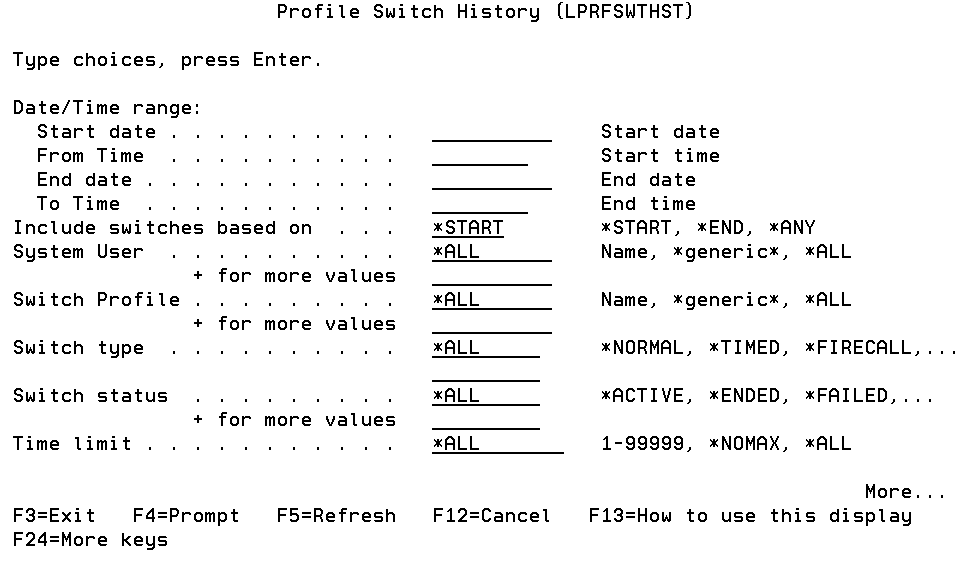Profile Switch History
The LPRFSWTHST command provides a method for viewing a history of profile switches based on user-specified criteria, such as date and time, switch type, and time limit.
How to Get There
From the Reports Menu, select option 3 (Profile Switch History).
Or, run the LPRFSWTHST command.
Options
Date/Time Range (TIMESTAMPS)
The Start Date and Time fields specify the first (earliest) of the switches to be included on the report. The Start Date and Time must specify a time before that of the End Date and Time.
It is permitted to specify a start date with no start time, however it is prohibited to specify a start time with no start date.
The End Date and Time fields specify the last (latest) of the switches to be included on the report. The End Date and Time must specify a time after that of the Start Date and Time.
It is permitted to specify an end date with no end time, however it is prohibited to specify an end time with no end date.
It is also permitted to specify a start date and time but not an end date and time, and vice versa. If the end date isn't specified, but the start date is, the end date is assumed to be today's date. If the start date isn't specified, but the end date is, the start date is assumed to be January 1, 1900.
Include switches based on (SELMTHD)
Specifies how profile switches are selected to be on the report.
The allowed values are:
System User (SYSUSER)
Specifies the system user for which the report is run.
Allowed values are a user profile, a generic value or the special value *ALL. Up to 10 different values may be selected.
Switch Profile (TGTPROF)
Specifies the switch profile for which the report is run.
Allowed values are a switch profile, a generic value, or the special value *ALL. Up to 10 different values may be selected.
Switch Type (SWTTYPE)
Specifies the switch type for which the report is run.
The allowed values are:
Up to two values may be selected.
Switch Status (SWTSTS)
Specifies the switch status for which the report is run.
The allowed values are:
Up to four values may be selected.
Time Limit (TIMELMT)
Specifies the time limit of the switch for which the report is run.
Allowed values are a number between 1 and 99999, the special value *NOMAX, or the special value *ALL.
Job Information (JOBINFO)
Specify the job information to be included in the output.
Call Ticket (CALLTKT)
Specifies the call ticket for which the report is run.
Allowed values are a call ticket, a generic value, and the special value *ALL.
Include Date (INCL)
Specify what additional information is to be included in the output.
Print output (PRINT)
Specifies if the report output is to be printed.
Allowed values are *YES and *NO.
Send Report to Outfile (DBFILE)
Specifies if the report output is to be sent to a database file.
Allowed values are *YES and *NO.
Output to an IFS file (IFSFILE)
Specifies if the report output is to be sent to an IFS file.
Allowed values are *YES and *NO.
Output Queue (OUTQ)
Specifies the output queue name to which a printed report is to be sent.
This is a required parameter if print output is selected.
Database file for output (DBOUTFILE)
Specifies the database file to which to send the report.
This is a required parameter if DB file output is selected. If the file does not already exist, it will be created for you.
Database output file member name (MBRNAME)
Specifies the name of the member of the database file to write to.
This is an optional parameter.
Action to take if the database file exists (EXISTDB)
Specifies the action to take if the database file member already exists.
The allowed values are:
IFS file for output (IFSOUTFILE)
Specifies the IFS file to which the report will be sent.
This is a required parameter if IFS file output is selected. If the file does not already exist, it will be created for you. Specify the path that the file is sent to.
You must have sufficient access rights to the specified IFS file, including all directories in the path, to create and to write to this file.
Action to take if the IFS file exists (EXISTIFS)
Specifies the action to take if the IFS file already exists.
The allowed values are:
*PUBLIC Authority (PUBAUTH).
Specifies the authority given to *PUBLIC for the output file specified in File Name (DBOUTFILE) or IFS File (IFSOUTFILE) parameters.
The allowed values are:
